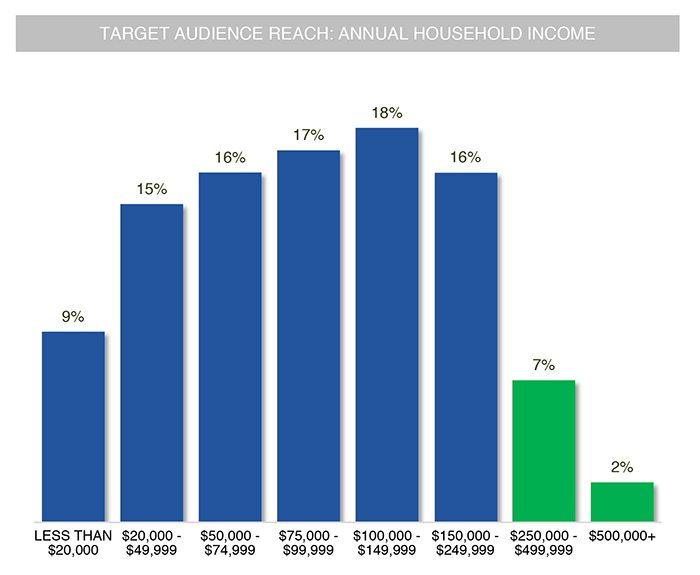
Target-audience penetration is key to a successful media relations strategy and the tactics that follow. Technology, research and insights provide detailed information about the audiences you need to reach and how to reach them. The results often surprise PR pros.
Conventional PR wisdom drives many targeting decisions to pursue ‘big numbers’ media. However, communicators make a mistake when they exclude smaller media outlets that offer a higher reach among target audiences.
For example, the NY Times appears on everyone’s top-tier media list and, for the most part, it merits inclusion. However, if everyone seeks the same destination, that path grows crowded and competitive. In addition to aiming for media targets with the highest reach, smart communicators also target more accessible media that attract a large concentration of the intended audience. In this way, target audience reach becomes a preferred metric over gross audience reach. In laymen’s terms, quality is more important than quantity (not to mention that we shouldn’t automatically assume conventional media choices are the most efficient way to reach certain niche audiences).
When considering target audiences and the media they consume, you must apply data, not just ‘big numbers’ but ‘smart numbers.’
For example, an ultra-luxury products retailer whose campaign touted expensive women’s jewelry for high-income individuals generated many placements in high-circulation outlets, but missed its target audience. In Figure 1 below, attribution technology determined target audience reach. The resulting demographic analysis of those who clicked on the story revealed that only 9 percent earned a sufficient annual household income to buy jewelry of such extravagance.

Source: The author
Media Targeting
Today’s media databases make it easy to make targeting decisions. In some ways, they make it too easy. So easy that some communicators assume ‘it’s only an email’ and blast their pitch indiscriminately, regardless of whether a journalist or media outlet considers the content relevant.
A journalist’s time is extraordinarily precious. The US Bureau of Labor and Statistics reports the number of PR pros outnumber journalists roughly 5-to-1. If you were an overworked journalist, wouldn’t you gladly receive highly targeted pitches aimed purposely at your audience?
Targeted outreach delivers better results and improves the probability that a meaningful relationship between journalist and communicator will emerge. On the other hand, pitches based on whim or even ‘coffee table logic,’ an informed assumption, lead to frustration among journalists, who find you and your pitches easy to ignore.
To some PR pros, the concept of a target audience strategy represents too large a departure or suggests an overly complicated process. For many, concerns relate to the risky shift from big numbers PR to smart numbers PR. Indeed, there’s the unknown reaction from senior executives who don’t know the difference.
The targeted audience reach approach certainly will lower media exposure but can you imagine the CEO who prefers quantity over quality, especially when quality also leads to additional revenue accompanied by cost and time efficiencies?
Creating A Media-Targeting Strategy
For a scientific fresh start for media targeting, consider the following steps. Granted, some of these recommendations require resources, but there is a lot you can do with even a small budget using similar logic:
- Access demographics databases to determine the best targets. The database identifies media with the highest likelihood of success given what readers, viewers and listeners say about themselves. Keep in mind that some of these media may be unknown to you now. If you can’t access such a database, ask advertising or media-buying colleagues to run the numbers for you
- Pitch these high-potential media, journalist and influencers while tracking their responses. Refine accordingly
- Use media content analysis to monitor who runs your content and your competitors,’ as well as the messages that appear. If coverage emerges from outlets that weren’t on your original target list, explore the degree to which they reach your target audience and consider adding them.
- Attribution technology is becoming increasingly accessible. If it’s available to you, use the software to track click-through behavior: Which media drove traffic to your website? Which news sites sparked downloads, job applications and business transactions? If they trigger the right behavior, reinforce your focus on these high-yield media.
- Apply findings to manage your effort toward continuous improvement. Use results as a sword and a shield to attack new media opportunities and defend against poor emotions-based media targeting requests.
The optimal media targets are those your target audience reads. They spark constructive behavioral responses, generate positive stories about your company and feature them frequently. A data-informed approach will focus your resources on media that is important, in which you perform well and your competitors are either absent or covered negatively.
Mark Weiner’s new book is “PR Technology, Data and Insights.”
